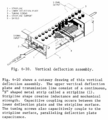Distributed deflection plates


In CRTs, a trade/off exists between writing rate, deflection sensitivity and spot size. Within a given technology (e.g. mono acceleration, post deflection acceleration or microchannel plate (MCP)), these three characteristics can be traded off against each other. Improve one and the others suffer. Improve the technology and all three can be improved simultaneously. Writing rate is important to observe single short-lived events, but is not important for repetitive signals. Spot size is important in showing detail in the waveform. Sensitivity is important mostly to permit greater bandwidth in vertical amplifiers.
CRTs have a finite frequency response and distributed deflection structures extend the CRT's bandwidth as well as aid the vertical amplifier by virtually eliminating the capacitive load on the vertical amplifier.
The CRT's frequency response is not as simple as an RLC circuit. A voltage step applied to the deflection plates simultaneously affects all the electrons between the plates. Those that are just exiting the plates see nothing as they continue on their way to the phosphor for display. Those that are at the entrance to the plates feel the effects of all voltage changes that take place during their transit through the plates. However, they bear the memory of any deflection plate voltage changes during their journey through the plates. The effects of any deflection plate voltage changes are delayed in proportion to their distance from the exit simply because it takes longer for the electrons to travel from the entrance to the exit of the plates. This is what makes the frequency response complex.
For example, if it takes 1 ns for an electron to travel the length of the plates (usually one on each side of the electron beam) and a 1 GHz sine wave is applied between the plates, the full 360 degrees of the sine wave causes the electron to move up and down from entrance to exit. When the drive voltage was going up at the time the beam entered the deflection plate area, by the time it is leaving, the drive voltage will be going down again, pushing the beam back to the center, i.e. the sensitivity is zero at this frequency.
Making the transit time shorter by shortening up the deflection plate improves the bandwidth, but reduces the deflection sensitivity by the same factor. The distributed deflection plate structure is a way around this, extending the bandwidth without reducing the deflection sensitivity. There is no performance trade off.
In the distributed deflection plate structure, the original deflection plates are cut up into individual segments. The capacitance of the deflection plates can then be made part of a lumped delay line by adding inductance between each of the segmented plates. These inductors inductors are inside the CRT.
Signals in a transmission line travel slowly. If done correctly, the electron beam velocity equals the signal velocity down the delay line. This reduces the time the electron beam spends between any particular deflection plate pair very short. Yet the electrons keep seeing the same voltage no matter where they are along the structure.
The lumped delay line is terminated at the end of the deflection structure outside the CRT. The end of this delay line needs to be terminated to prevent the drive signal being reflected back through the line. In Tektronix scopes, the termination resistor can often be seen attached to a second pair of vertical deflection terminals on the side of the CRT, which bring out the end of the transmission line. The transmission line has absorbed the plate capacitance. This means the vertical amplifier is driving a resistive load and not the capacitance of a long deflection plate.

History
Distributed deflection plates were introduced in the 580-series scopes in the late 1950s. Transistorized scopes followed with the upgrade of the 50 MHz 453 to the 150 MHz model 454 in 1967.
Typically, only the vertical deflection plates are distributed. An exception is the 7104 due to the high horizontal system bandwidth required (350 MHz).
| Model | Distributed Y plates | Distributed X plates |
|---|---|---|
| 11301 | yes | no |
| 11302 | yes | no |
| 2445 | yes | no |
| 2465 | yes | no |
| 2467 | yes | no |
| 453 | no | no |
| 454 | yes | no |
| 465 | no | no |
| 475 | yes | no |
| 485 | yes | no |
| 519 | yes | no |
| 53x | no | no |
| 54x | no | no |
| 55x | no | no |
| 56x | no | no |
| 58x | yes | no |
| 7403 | no | no |
| 7503 | no | no |
| 7504 | no | no |
| 7603 | no | no |
| 7612D | no | no |
| 7704 | yes | no |
| 7704A | yes | no |
| 7844 | yes | no |
| 7854 | yes | no |
| 7903 | yes | no |
| 7904 | yes | no |
| 7904A | yes | no |
| 7912 | yes | no |
| 7103 | yes | yes |
| 7104 | yes | yes |
| 7250 | yes | yes |
| SCD1000 | yes | yes |
| SCD5000 | yes | yes |
Literature
- US Patent 2,922,074, "Electron Beam Deflection Structure" by Cliff Moulton
- Peter Keller, The Cathode-Ray Tube: Technology, History, and Applications, . Palisades Press, 1991. ISBN 0963155903, 9780963155900
- Oscilloscope Cathode-Ray Tube Concepts, Chuck Devere, 1969
- Addis Analog Circuit Design Art, Science, Personalities
-
Distributed deflection plates in 154-0850-01 CRT (2445,2455)
-
Deflection system of 519 scope


